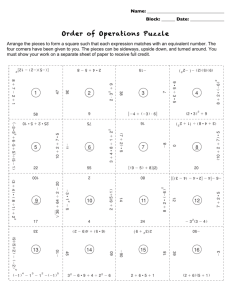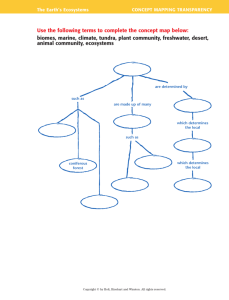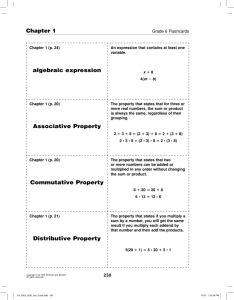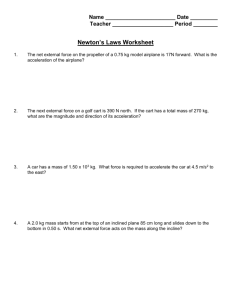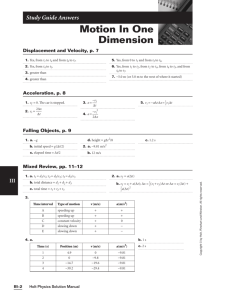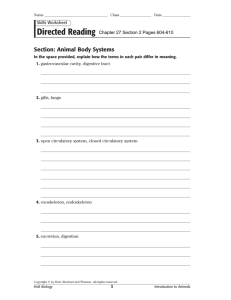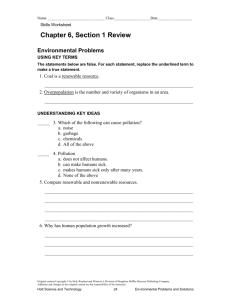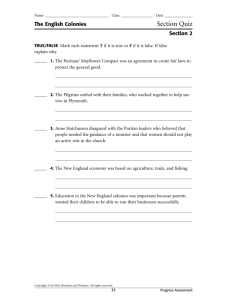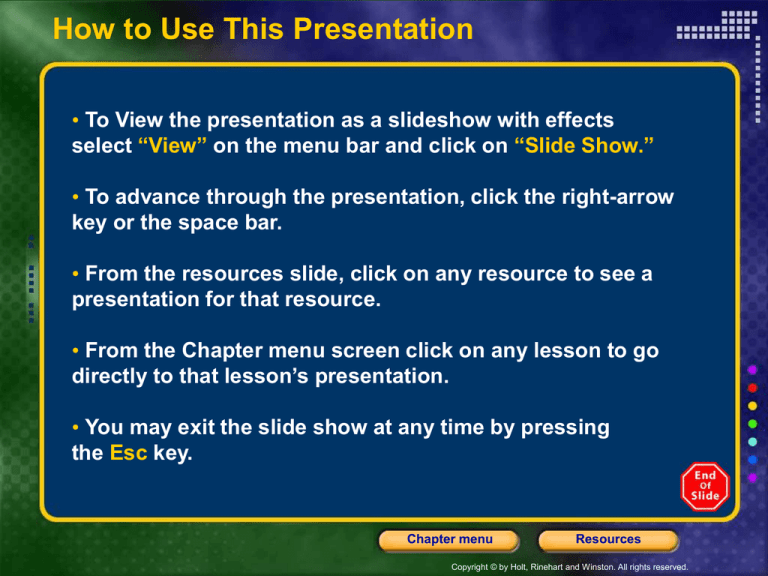
How to Use This Presentation
• To View the presentation as a slideshow with effects
select “View” on the menu bar and click on “Slide Show.”
• To advance through the presentation, click the right-arrow
key or the space bar.
• From the resources slide, click on any resource to see a
presentation for that resource.
• From the Chapter menu screen click on any lesson to go
directly to that lesson’s presentation.
• You may exit the slide show at any time by pressing
the Esc key.
Chapter menu
Resources
Copyright © by Holt, Rinehart and Winston. All rights reserved.
Resources
Chapter Presentation
Transparencies
Visual Concepts
Standardized Test Prep
Brain Food Video Quiz
Chapter menu
Resources
Copyright © by Holt, Rinehart and Winston. All rights reserved.
Chapter 2
Earth as a System
Table of Contents
Section 1 Earth: A Unique Planet
Section 2 Energy in the Earth System
Section 3 Ecology
Chapter menu
Resources
Copyright © by Holt, Rinehart and Winston. All rights reserved.
Chapter 2
Section 1 Earth: A Unique Planet
Objectives
• Describe the size and shape of Earth.
• Describe the compositional and structural layers of
Earth’s interior.
• Identify the possible source of Earth’s magnetic field.
• Summarize Newton’s law of gravitation.
Chapter menu
Resources
Copyright © by Holt, Rinehart and Winston. All rights reserved.
Chapter 2
Section 1 Earth: A Unique Planet
Earth Basics
• Earth is the third planet from the sun in our solar system.
• Earth formed about 4.6 billion years ago and is made mostly of
rock.
• Approximately 70% of Earth’s surface is covered by a thin layer
of water known as the global ocean.
• Earth is an oblate sphere, or a slightly flattened sphere. Earth’s
pole-to-pole circumference is 40,007 km. Its equatorial
circumference is 40,074 km.
• Earth’s average diameter is 12,756 km.
Chapter menu
Resources
Copyright © by Holt, Rinehart and Winston. All rights reserved.
Chapter 2
Section 1 Earth: A Unique Planet
Earth’s Interior
• Scientists have made important discoveries about
Earth’s interior through studies of seismic waves.
• Seismic waves are vibrations that travel through
Earth and that are caused by earthquakes and by
explosions near Earth’s surface.
• By studying seismic waves as they travel through
Earth, scientists have determined that Earth is made
up of three major compositional zones and five major
structural zones.
Chapter menu
Resources
Copyright © by Holt, Rinehart and Winston. All rights reserved.
Chapter 2
Section 1 Earth: A Unique Planet
Earth’s Interior, continued
Compositional Zones of Earth’s Interior
• crust the thin and solid outermost layer of Earth that lies above
the mantle
• Oceanic crust, which lies under the oceans, is only 5 to 10 km
thick. The continental crust varies in thickness from 15 km to 80
km.
• mantle in Earth science, the layer of rock that lies between
Earth’s crust and core
• The mantle is nearly 2,900 km thick and makes up almost twothirds.
Chapter menu
Resources
Copyright © by Holt, Rinehart and Winston. All rights reserved.
Chapter 2
Section 1 Earth: A Unique Planet
Earth’s Interior, continued
Compositional Zones of Earth’s Interior, continued
• core the central part of Earth that lies below the
mantle
• The center of Earth is a sphere composed mainly of
nickel and iron whose radius is about 3,500 km.
Chapter menu
Resources
Copyright © by Holt, Rinehart and Winston. All rights reserved.
Chapter 2
Section 1 Earth: A Unique Planet
Earth’s Interior, continued
Reading Check
Explain why scientists have to rely on indirect
observations to study Earth’s interior.
Chapter menu
Resources
Copyright © by Holt, Rinehart and Winston. All rights reserved.
Chapter 2
Section 1 Earth: A Unique Planet
Earth’s Interior, continued
Reading Check
Explain why scientists have to rely on indirect
observations to study Earth’s interior.
Indirect observations are the only means available for
exploring Earth’s interior at depths too great to be
reached by drilling.
Chapter menu
Resources
Copyright © by Holt, Rinehart and Winston. All rights reserved.
Chapter 2
Section 1 Earth: A Unique Planet
Earth’s Interior, continued
Structural Zones of Earth’s Interior
• The three compositional zones of Earth’s interior are divided into
five structural zones.
• lithosphere the solid, outer layer of Earth that consists of the
crust and the rigid upper part of the mantle
• The rigid lithosphere is between 15km and 300 km thick.
• asthenosphere the solid, plastic layer of the mantle beneath
the lithosphere; made of mantle rock that flows very slowly,
which allows tectonic plates to move on top of it
• The plastic asthenosphere is about 200 km thick.
Chapter menu
Resources
Copyright © by Holt, Rinehart and Winston. All rights reserved.
Chapter 2
Section 1 Earth: A Unique Planet
Earth’s Interior, continued
Structural Zones of Earth’s Interior, continued
• mesosphere literally, the “middle sphere”; the strong, lower part
of the mantle between the asthenosphere and the outer core
• The mesosphere reaches from the bottom of the asthenosphere
to a depth of about 2,900 km.
• Below the mesosphere is the liquid outer core.
• The outer core surrounds the solid inner core, which begins at a
depth of 5,150 km.
Chapter menu
Resources
Copyright © by Holt, Rinehart and Winston. All rights reserved.
Chapter 2
Section 1 Earth: A Unique Planet
Earth’s Interior, continued
The diagram below shows the layers of Earth’s interior.
Chapter menu
Resources
Copyright © by Holt, Rinehart and Winston. All rights reserved.
Chapter 2
Section 1 Earth: A Unique Planet
Structure of the Earth
Chapter menu
Resources
Copyright © by Holt, Rinehart and Winston. All rights reserved.
Chapter 2
Section 1 Earth: A Unique Planet
Earth as a Magnet
• Earth’s magnetic field extends beyond the
atmosphere and affects a region of space called the
magnetosphere.
• Scientists think that motions within the liquid iron of
Earth’s outer core produce electric currents that in
turn create Earth’s magnetic field.
Chapter menu
Resources
Copyright © by Holt, Rinehart and Winston. All rights reserved.
Chapter 2
Section 1 Earth: A Unique Planet
Earth’s Magnetic Field
Chapter menu
Resources
Copyright © by Holt, Rinehart and Winston. All rights reserved.
Chapter 2
Section 1 Earth: A Unique Planet
Earth’s Gravity
• Gravity is the force of attraction that exists between
all matter in the universe.
• According to Newton’s law of gravitation, the force of
attraction between any two objects depends on the
masses of the objects and the distance between the
objects.
• The larger the masses of two objects are and the
closer together the objects are, the greater the force
of gravity between the objects will be.
Chapter menu
Resources
Copyright © by Holt, Rinehart and Winston. All rights reserved.
Chapter 2
Section 1 Earth: A Unique Planet
Earth’s Gravity, continued
Weight and Mass
• Weight is a measure of the strength of the pull of gravity on an
object.
• An object’s weight depends on its mass and its distance from
Earth’s center.
Weight and Location
• Because the distance between Earth’s surface and its center is
greater at the equator than at the poles, the weight of an object
at the equator is about 0.3% less than its weight at the North
Pole.
Chapter menu
Resources
Copyright © by Holt, Rinehart and Winston. All rights reserved.
Chapter 2
Section 2 Energy in the Earth
System
Objectives
• Compare an open system with a closed system.
• List the characteristics of Earth’s four major spheres.
• Identify the two main sources of energy in the Earth
system.
• Identify four processes in which matter and energy
cycle on Earth.
Chapter menu
Resources
Copyright © by Holt, Rinehart and Winston. All rights reserved.
Chapter 2
Section 2 Energy in the Earth
System
Earth-System Science
• Some Earth scientists combine knowledge of several fields of
Earth science in order to study Earth as a system.
• system a set of particles or interacting components considered
to be a distinct physical entity for the purpose of study
• All systems have boundaries, and many systems have matter
and energy that flow though them.
• Even though each system can be described separately, all
systems are linked. A large and complex system, such as the
Earth system, operates as a result of the combination of smaller,
interrelated systems.
Chapter menu
Resources
Copyright © by Holt, Rinehart and Winston. All rights reserved.
Chapter 2
Section 2 Energy in the Earth
System
Earth-System Science, continued
• The operation of the Earth system is a result of interaction
between the two most basic components of the universe: matter
and energy.
• Matter is anything that has mass and takes up space.
• Energy is defined as the ability to do work. Energy can be
transferred in a variety of forms, including heat, light, vibrations,
or electromagnetic waves.
• A system can be described by the way that matter and energy
are transferred within the system or to and from other systems.
Chapter menu
Resources
Copyright © by Holt, Rinehart and Winston. All rights reserved.
Chapter 2
Section 2 Energy in the Earth
System
Earth-System Science, continued
Closed Systems
• A closed system is a system in which energy, but not matter is
exchanged with the surroundings.
Open Systems
• An open system is a system in which both energy and matter
are exchanged with the surroundings.
Chapter menu
Resources
Copyright © by Holt, Rinehart and Winston. All rights reserved.
Chapter 2
Section 2 Energy in the Earth
System
Earth-System Science, continued
The figure below compares open and closed systems.
Chapter menu
Resources
Copyright © by Holt, Rinehart and Winston. All rights reserved.
Chapter 2
Section 2 Energy in the Earth
System
Earth-System Science, continued
The Earth System
• Technically, all systems that make up the Earth system are
open.
• However, the Earth system is almost a closed system because
matter exchange is limited.
• Energy enters the system in the form of sunlight and is released
into space as heat.
• Only a small amount of dust and rock from space enters the
system, and only a fraction of the hydrogen atoms in the
atmosphere escape into space.
Chapter menu
Resources
Copyright © by Holt, Rinehart and Winston. All rights reserved.
Chapter 2
Section 2 Energy in the Earth
System
Earth-System Science, continued
Reading Check
What types of matter and energy are exchanged
between Earth and space?
Chapter menu
Resources
Copyright © by Holt, Rinehart and Winston. All rights reserved.
Chapter 2
Section 2 Energy in the Earth
System
Earth-System Science, continued
Reading Check
What types of matter and energy are exchanged
between Earth and space?
Dust and rock come to Earth from space, while
hydrogen atoms from the atmosphere enter space
from Earth. Solar energy enters Earth’s atmosphere
and reradiated energy leaves Earth.
Chapter menu
Resources
Copyright © by Holt, Rinehart and Winston. All rights reserved.
Chapter 2
Section 2 Energy in the Earth
System
Earth’s Four Spheres
• Matter on Earth is in solid, liquid, and gaseous states.
The Earth system is composed of four “spheres” that
are storehouses of all of the planet’s matter.
The Atmosphere
• atmosphere a mixture of gases that surrounds a
planet or moon
• The atmosphere provides the air you breathe and
shields Earth from the sun’s harmful radiation.
Chapter menu
Resources
Copyright © by Holt, Rinehart and Winston. All rights reserved.
Chapter 2
Section 2 Energy in the Earth
System
Earth’s Four Spheres, continued
The Hydrosphere
• hydrosphere the portion of Earth that is water
• Water covers 71% of Earth’s surface.
• Water in the hydrosphere occur in the form of
oceans, lakes, rivers, streams, glaciers and ice
sheets, and groundwater.
Chapter menu
Resources
Copyright © by Holt, Rinehart and Winston. All rights reserved.
Chapter 2
Section 2 Energy in the Earth
System
Earth’s Four Spheres, continued
The Geosphere
• geosphere the mostly solid, rocky part of Earth;
extends from the center of the core to the surface of
the crust
• The geosphere includes all of the rock and soil on the
surface of the continents and on the ocean floor.
• The geosphere also includes the solid and molten
interior of Earth.
Chapter menu
Resources
Copyright © by Holt, Rinehart and Winston. All rights reserved.
Chapter 2
Section 2 Energy in the Earth
System
Earth’s Four Spheres, continued
The Biosphere
• biosphere the part of Earth where life exists; includes all of the
living organisms on Earth
• The biosphere is composed of all of the forms of life in the
geosphere, in the hydrosphere, and in the atmosphere, as well
as any organic matter that has not decomposed.
• The biosphere extends from the deepest parts of the ocean to
the atmosphere a few kilometers above Earth’s surface.
Chapter menu
Resources
Copyright © by Holt, Rinehart and Winston. All rights reserved.
Chapter 2
Section 2 Energy in the Earth
System
Earth’s Energy Budget
• The transfers of energy between Earth’s spheres can be thought
of as parts of an energy budget.
• The first law of thermodynamics states that energy is transferred
between systems, but it cannot be created or destroyed.
• The second law of thermodynamics states that when energy
transfer occurs, matter becomes less organized with time. Thus,
the universe’s energy is spread out more uniformly over time.
• The constant exchange of matter and energy between Earth’s
spheres happens through chemical reactions, radioactive decay,
the radiation of energy ,and the growth and decay of organisms.
Chapter menu
Resources
Copyright © by Holt, Rinehart and Winston. All rights reserved.
Chapter 2
Section 2 Energy in the Earth
System
Earth’s Energy Budget, continued
The figure below shows Earth’s energy budget.
Chapter menu
Resources
Copyright © by Holt, Rinehart and Winston. All rights reserved.
Chapter 2
Section 2 Energy in the Earth
System
Earth’s Energy Budget, continued
Reading Check
Define energy budget.
Chapter menu
Resources
Copyright © by Holt, Rinehart and Winston. All rights reserved.
Chapter 2
Section 2 Energy in the Earth
System
Earth’s Energy Budget, continued
Reading Check
Define energy budget.
An energy budget is the total distribution of energy to,
from, and between Earth’s various spheres.
Chapter menu
Resources
Copyright © by Holt, Rinehart and Winston. All rights reserved.
Chapter 2
Section 2 Energy in the Earth
System
Earth’s Energy Budget, continued
Internal Sources of Energy
• When Earth formed about 4.6 billion years ago, its interior was
heated by radioactive decay and gravitational contraction.
• The decay of radioactive atoms still generates enough heat to
keep Earth’s interior hot. Earth’ interior also retains much of the
energy from the planet’s formation.
• By the process of convection, the heat in Earth’s interior is
transferred through the layers of Earth and is released at Earth’s
surface.
Chapter menu
Resources
Copyright © by Holt, Rinehart and Winston. All rights reserved.
Chapter 2
Section 2 Energy in the Earth
System
Earth’s Energy Budget, continued
External Energy Sources
• Earth’s most important external energy source is the sun.
• Solar radiation warms Earth’s atmosphere and surface. This
heating causes the movement of air masses, which generates
winds and ocean currents. Many chemical reactions on Earth
also require solar energy.
• Another important external source of energy is gravitational
energy from the moon and sun. This energy helps generate
tides that cause currents and drive the mixing of ocean water.
Chapter menu
Resources
Copyright © by Holt, Rinehart and Winston. All rights reserved.
Chapter 2
Section 2 Energy in the Earth
System
Cycles in the Earth System
• A cycle is a group of processes in which matter and energy
repeatedly move through a series of reservoirs.
• A reservoir is a place where matter or energy is stored.
• Many elements on Earth cycle between reservoirs. These cycles
rely on energy sources to drive them.
• The length of time that energy or matter spends in a reservoir
can vary from a few hours to several million years.
Chapter menu
Resources
Copyright © by Holt, Rinehart and Winston. All rights reserved.
Chapter 2
Section 2 Energy in the Earth
System
Biogeochemical Cycle
Chapter menu
Resources
Copyright © by Holt, Rinehart and Winston. All rights reserved.
Chapter 2
Section 2 Energy in the Earth
System
Cycles in the Earth System, continued
The Nitrogen Cycle
• In the nitrogen cycle, nitrogen moves from the air to soil, from
soil to plants and animals, and back to air again.
• Nitrogen is removed from air mainly by the action of nitrogenfixing bacteria in the soil.
• The nitrogen enters plants, which are eaten by animals. The
nitrogen is returned to the soil by decay and by animal wastes.
• Chemical processes that occur in the soil then release the
nitrogen back into the air.
Chapter menu
Resources
Copyright © by Holt, Rinehart and Winston. All rights reserved.
Chapter 2
Section 2 Energy in the Earth
System
Cycles in the Earth System, continued
The figure below illustrates the nitrogen cycle.
Chapter menu
Resources
Copyright © by Holt, Rinehart and Winston. All rights reserved.
Chapter 2
Section 2 Energy in the Earth
System
Cycles in the Earth System, continued
Reading Check
Identify two nitrogen reservoirs on Earth.
Chapter menu
Resources
Copyright © by Holt, Rinehart and Winston. All rights reserved.
Chapter 2
Section 2 Energy in the Earth
System
Cycles in the Earth System, continued
Reading Check
Identify two nitrogen reservoirs on Earth.
Answers should include two of the following: the
atmosphere, animals, soil, and plants.
Chapter menu
Resources
Copyright © by Holt, Rinehart and Winston. All rights reserved.
Chapter 2
Section 2 Energy in the Earth
System
Cycles in the Earth System, continued
The Carbon Cycle
• Carbon moves through all four spheres through the carbon
cycle.
• In the short-term carbon cycle, plants convert carbon dioxide,
CO2, from the atmosphere into carbohydrates. When organisms’
bodies break down the carbohydrates and release some of the
carbon back into the air as CO2 or through their organic wastes
as CO2 or methane, CH4.
• In the long-term carbon cycle, carbon is stored in the geosphere
in a type of rock called a carbonate.
Chapter menu
Resources
Copyright © by Holt, Rinehart and Winston. All rights reserved.
Chapter 2
Section 2 Energy in the Earth
System
Cycles in the Earth System, continued
The figure below illustrates the carbon cycle.
Chapter menu
Resources
Copyright © by Holt, Rinehart and Winston. All rights reserved.
Chapter 2
Section 2 Energy in the Earth
System
Cycles in the Earth System, continued
The Phosphorus Cycle
• During the phosphorus cycle, phosphorus moves through every
sphere except the atmosphere.
• Phosphorus enters soil and water when rock breaks down,
when phosphorus in rock dissolves in water, or when organisms
excrete phosphorus in their waste.
• Plants absorb phosphorus through their roots and incorporate
the phosphorus into their tissues.
• Animals absorb the phosphorus when they eat the plants. When
the animals die, the phosphorus returns to the environment
through decomposition.
Chapter menu
Resources
Copyright © by Holt, Rinehart and Winston. All rights reserved.
Chapter 2
Section 2 Energy in the Earth
System
Cycles in the Earth System, continued
The Water Cycle
• The movement of water from the atmosphere to Earth’s surface
and back to the atmosphere is called the water cycle.
• In the water cycle, water changes from liquid water to water
vapor through the energy transfers involved in evaporation and
transpiration. During these processes, water absorbs heat and
changes into a gaseous state.
• When the water loses energy, it condenses to form water
droplets, such as those that form clouds and fall to Earth’s
surface as precipitation.
Chapter menu
Resources
Copyright © by Holt, Rinehart and Winston. All rights reserved.
Chapter 2
Section 2 Energy in the Earth
System
Humans and the Earth System
• All natural cycles can be altered by human activities.
• The carbon cycle is affected when humans use fossil
fuels.
• The nitrogen and phosphorus cycles are affected by
agriculture.
• Humans must be careful to moderate their influences
on natural systems.
Chapter menu
Resources
Copyright © by Holt, Rinehart and Winston. All rights reserved.
Chapter 2
Section 3 Ecology
Objectives
• Define ecosystem.
• Identify three factors that control the balance of an
ecosystem.
• Summarize how energy is transferred through an
ecosystem.
• Describe one way that ecosystems respond to
environmental change.
Chapter menu
Resources
Copyright © by Holt, Rinehart and Winston. All rights reserved.
Chapter 2
Section 3 Ecology
Ecosystems
• Ecology is the study of the complex relationships
between living things and their nonliving, or abiotic
environment.
• ecosystem a community of organisms and their
abiotic environment
• An ecosystem may be as large as an ocean or as
small as a rotting log. The largest ecosystem is the
entire biosphere.
Chapter menu
Resources
Copyright © by Holt, Rinehart and Winston. All rights reserved.
Chapter 2
Section 3 Ecology
Ecosystems, continued
• Organisms that make their own food are called producers. Most
producers use energy from the sun to produce their own food.
• Consumers are organisms that get their energy by eating other
organisms. Consumers may get energy by eating producers or
by eating other consumers.
• Some consumers get energy by breaking down dead
organisms. These consumers are called decomposers.
• To remain healthy, an ecosystem needs to have a balance of
producers, consumers, and decomposers.
Chapter menu
Resources
Copyright © by Holt, Rinehart and Winston. All rights reserved.
Chapter 2
Section 3 Ecology
Balancing Forces in Ecosystems
• Because amounts of matter and energy in an
ecosystem are limited, the population growth within
the ecosystem is limited, too.
• carrying capacity the largest population than an
environment can support at any given time
• Carrying capacity depends on available resources
and on how easily matter and energy cycle between
life-forms and the environment in the ecosystem.
Chapter menu
Resources
Copyright © by Holt, Rinehart and Winston. All rights reserved.
Chapter 2
Section 3 Ecology
Balancing Forces in Ecosystems, continued
Ecological Responses to Change
• In general, ecosystems react to changes in ways that maintain
or restore balance to the ecosystem.
• Environmental change in the form of a sudden disturbance can
damage and disrupt ecosystems. However, over time,
organisms will migrate back into damaged areas in predictable
patterns.
• Ecosystems are resilient and tend to restore a community of
organisms to its original state unless the physical environment is
permanently altered.
Chapter menu
Resources
Copyright © by Holt, Rinehart and Winston. All rights reserved.
Chapter 2
Section 3 Ecology
Balancing Forces in Ecosystems, continued
Reading Check
Explain the relationship between carrying capacity
and the amount of matter and energy in an
ecosystem.
Chapter menu
Resources
Copyright © by Holt, Rinehart and Winston. All rights reserved.
Chapter 2
Section 3 Ecology
Balancing Forces in Ecosystems, continued
Reading Check
Explain the relationship between carrying capacity
and the amount of matter and energy in an
ecosystem.
The amount of matter and energy in an ecosystem
can supply a population of a given size. This
maximum population is the carrying capacity of the
ecosystem.
Chapter menu
Resources
Copyright © by Holt, Rinehart and Winston. All rights reserved.
Chapter 2
Section 3 Ecology
Balancing Forces in Ecosystems, continued
Energy Transfer
• The ultimate source of energy for almost every ecosystem is
the sun.
• Producers, such as plants, capture solar energy by a
chemical process called photosynthesis. This captured energy
then flows through the ecosystem from the producers, to the
consumers, and finally to the decomposers.
• As matter and energy cycle through an ecosystem, chemical
elements are combined and recombined. Each chemical
change results in either the temporary storage of energy or
the loss of energy.
Chapter menu
Resources
Copyright © by Holt, Rinehart and Winston. All rights reserved.
Chapter 2
Section 3 Ecology
Balancing Forces in Ecosystems, continued
Energy Transfer, continued
• An energy pyramid is one way to see how energy is lost as it
moves through the ecosystem.
• Producers form the base of the pyramid. Consumers that eat the
producers are the next level of the pyramid. Animals that eat
those consumers form the upper levels of the pyramid.
• As you move up the pyramid, more energy is lost at each level.
Therefore, the least amount of energy is available to organisms
at the top of the pyramid.
Chapter menu
Resources
Copyright © by Holt, Rinehart and Winston. All rights reserved.
Chapter 2
Section 3 Ecology
Balancing Forces in Ecosystems, continued
Food Chains and Food Webs
• The sequence in which organisms consume other
organisms can be represented by a food chain or by
a food web.
• food web a diagram that shows the feeding
relationships among organisms in an ecosystem
Chapter menu
Resources
Copyright © by Holt, Rinehart and Winston. All rights reserved.
Chapter 2
Section 3 Ecology
Balancing Forces in Ecosystems, continued
The figure below illustrates a food web.
Chapter menu
Resources
Copyright © by Holt, Rinehart and Winston. All rights reserved.
Chapter 2
Section 3 Ecology
Food Chains and Food Webs
Chapter menu
Resources
Copyright © by Holt, Rinehart and Winston. All rights reserved.
Chapter 2
Section 3 Ecology
Human Stewardship of the Environment
• All of Earth’s systems are interconnected, and
changes in one system may affect the operation of
other systems.
• Ecological balances can be disrupted by human
activities, such as overconsumption of resources and
pollution.
• To help ensure the ongoing health and productivity of
the Earth system, many people work to use Earth’s
resources wisely.
Chapter menu
Resources
Copyright © by Holt, Rinehart and Winston. All rights reserved.
Chapter 2
Maps in Action
Maps in Action
Concentration of Plant Life on Earth
Chapter menu
Resources
Copyright © by Holt, Rinehart and Winston. All rights reserved.
Chapter 2
Earth as a System
Brain Food Video Quiz
Chapter menu
Resources
Copyright © by Holt, Rinehart and Winston. All rights reserved.
Chapter 2
Standardized Test Prep
Multiple Choice
1. The crust and the rigid upper part of the mantle are
found in what part of the Earth?
A. the asthenosphere
B. the lithosphere
C. the mesosphere
D. the stratosphere
Chapter menu
Resources
Copyright © by Holt, Rinehart and Winston. All rights reserved.
Chapter 2
Standardized Test Prep
Multiple Choice, continued
1. The crust and the rigid upper part of the mantle are
found in what part of the Earth?
A. the asthenosphere
B. the lithosphere
C. the mesosphere
D. the stratosphere
Chapter menu
Resources
Copyright © by Holt, Rinehart and Winston. All rights reserved.
Chapter 2
Standardized Test Prep
Multiple Choice, continued
2. Because phosphorus rarely occurs as a gas, the
phosphorus cycle mainly occurs between the?
F.
G.
H.
I.
biosphere, geosphere,and hydrosphere
biosphere, geosphere, and atmosphere
geosphere, hydrosphere, and atmosphere
biosphere, hydrosphere, and atmosphere
Chapter menu
Resources
Copyright © by Holt, Rinehart and Winston. All rights reserved.
Chapter 2
Standardized Test Prep
Multiple Choice, continued
2. Because phosphorus rarely occurs as a gas, the
phosphorus cycle mainly occurs between the?
F.
G.
H.
I.
biosphere, geosphere,and hydrosphere
biosphere, geosphere, and atmosphere
geosphere, hydrosphere, and atmosphere
biosphere, hydrosphere, and atmosphere
Chapter menu
Resources
Copyright © by Holt, Rinehart and Winston. All rights reserved.
Chapter 2
Standardized Test Prep
Multiple Choice, continued
3. How are scientists able to study the composition and
size of the interior layers of Earth?
A. by direct observation
B. by analyzing surface rock samples
C. by using seismic waves
D. by deep-drilling into the interior layers
Chapter menu
Resources
Copyright © by Holt, Rinehart and Winston. All rights reserved.
Chapter 2
Standardized Test Prep
Multiple Choice, continued
3. How are scientists able to study the composition and
size of the interior layers of Earth?
A. by direct observation
B. by analyzing surface rock samples
C. by using seismic waves
D. by deep-drilling into the interior layers
Chapter menu
Resources
Copyright © by Holt, Rinehart and Winston. All rights reserved.
Chapter 2
Standardized Test Prep
Multiple Choice, continued
4. Which of the following methods of internal energy
transfer drives volcanic activity on Earth’s surface?
F. radioactive decay
G. convection
H. kinetic transfer
I. conduction
Chapter menu
Resources
Copyright © by Holt, Rinehart and Winston. All rights reserved.
Chapter 2
Standardized Test Prep
Multiple Choice, continued
4. Which of the following methods of internal energy
transfer drives volcanic activity on Earth’s surface?
F. radioactive decay
G. convection
H. kinetic transfer
I. conduction
Chapter menu
Resources
Copyright © by Holt, Rinehart and Winston. All rights reserved.
Chapter 2
Standardized Test Prep
Multiple Choice, continued
5. Earth’s primary external energy source is
A. cosmic radiation.
B. the moon.
C. distant stars.
D. the sun.
Chapter menu
Resources
Copyright © by Holt, Rinehart and Winston. All rights reserved.
Chapter 2
Standardized Test Prep
Multiple Choice, continued
5. Earth’s primary external energy source is
A. cosmic radiation.
B. the moon.
C. distant stars.
D. the sun.
Chapter menu
Resources
Copyright © by Holt, Rinehart and Winston. All rights reserved.
Chapter 1
Standardized Test Prep
Short Response
6. What do decomposers break down to obtain energy?
Chapter menu
Resources
Copyright © by Holt, Rinehart and Winston. All rights reserved.
Chapter 1
Standardized Test Prep
Short Response, continued
6. What do decomposers break down to obtain energy?
dead organisms
Chapter menu
Resources
Copyright © by Holt, Rinehart and Winston. All rights reserved.
Chapter 2
Standardized Test Prep
Short Response, continued
7. What scientific principle states that energy can be
transferred but that it cannot be created or
destroyed?
Chapter menu
Resources
Copyright © by Holt, Rinehart and Winston. All rights reserved.
Chapter 2
Standardized Test Prep
Short Response, continued
7. What scientific principle states that energy can be
transferred but that it cannot be created or
destroyed?
First Law of Thermodynamics
Chapter menu
Resources
Copyright © by Holt, Rinehart and Winston. All rights reserved.
Chapter 1
Standardized Test Prep
Reading Skills
Read the passage below. Then, answer questions 8–9.
Acid Rain
Acid rain is rain, snow, fog, dew, or sleet that has a pH that is lower than the pH
of normal precipitation. Acid rain occurs primarily as a result of the combustion of
fossil fuels—a process that produces, as byproducts, oxides of nitrogen and sulfur
dioxide. When combined with water in the atmosphere, these compounds form nitric
acid and sulfuric acid. When it falls to Earth, acid rain has profound effects. It harms
forests by damaging tree leaves and bark, which leaves them vulnerable to weather,
disease, and parasites. Similarly, it damages crops. And it damages aquatic
ecosystems by causing the death of all but the hardiest species. Because of the
extensive damage that acid rain causes, the U.S. Environmental Protection Agency
limits the amount of sulfur dioxide and nitrogen oxides that can be emitted by
factories, power plants, and motor vehicles.
Chapter menu
Resources
Copyright © by Holt, Rinehart and Winston. All rights reserved.
Chapter 2
Standardized Test Prep
Reading Skills, continued
8. According to the passage, which of the following
contributes to the problem of acid rain?
A. the use of fossil fuels in power plants and motor
vehicles
B. parasites and diseases that harm tree leaves and
bark
C. the release of nitrogen into the atmosphere by
aquatic ecosystems
D. damaged crops that release too many gases into
the atmosphere
Chapter menu
Resources
Copyright © by Holt, Rinehart and Winston. All rights reserved.
Chapter 2
Standardized Test Prep
Reading Skills, continued
8. According to the passage, which of the following
contributes to the problem of acid rain?
A. the use of fossil fuels in power plants and motor
vehicles
B. parasites and diseases that harm tree leaves and
bark
C. the release of nitrogen into the atmosphere by
aquatic ecosystems
D. damaged crops that release too many gases into
the atmosphere
Chapter menu
Resources
Copyright © by Holt, Rinehart and Winston. All rights reserved.
Chapter 2
Standardized Test Prep
Reading Skills, continued
9. Which of the following statements can be inferred
from the information in the passage?
F. Acid rain is a natural problem that will correct
itself if given enough time.
G. Ecosystems damaged by acid rain adapt so that
they will not be damaged in the future.
H. Human activities are largely to blame for the
problem of acid rain.
I. Acid rain is a local phenomenon and damages
plants and animals only near power plants or
roadways.
Chapter menu
Resources
Copyright © by Holt, Rinehart and Winston. All rights reserved.
Chapter 2
Standardized Test Prep
Reading Skills, continued
9. Which of the following statements can be inferred
from the information in the passage?
F. Acid rain is a natural problem that will correct
itself if given enough time.
G. Ecosystems damaged by acid rain adapt so that
they will not be damaged in the future.
H. Human activities are largely to blame for the
problem of acid rain.
I. Acid rain is a local phenomenon and damages
plants and animals only near power plants or
roadways.
Chapter menu
Resources
Copyright © by Holt, Rinehart and Winston. All rights reserved.
Chapter 2
Standardized Test Prep
Interpreting Graphics
Use the figure below to answer question 10. The figure
shows the interior layers of Earth. The layers in the
diagram are representative of arrangement and are
not drawn to scale.
Chapter menu
Resources
Copyright © by Holt, Rinehart and Winston. All rights reserved.
Chapter 2
Standardized Test Prep
Interpreting Graphics, continued
10. Which layer of Earth’s interior does not transmit S
waves?
F.
G.
H.
I.
layer B
layer C
layer D
layer E
Chapter menu
Resources
Copyright © by Holt, Rinehart and Winston. All rights reserved.
Chapter 2
Standardized Test Prep
Interpreting Graphics, continued
10. Which layer of Earth’s interior does not transmit S
waves?
F.
G.
H.
I.
layer B
layer C
layer D
layer E
Chapter menu
Resources
Copyright © by Holt, Rinehart and Winston. All rights reserved.
Chapter 2
Standardized Test Prep
Interpreting Graphics, continued
Use the figure below to answer questions 11–12. The
figure shows predicted world-wide energy
consumption by fuel type between the years 2001
and 2025.
Chapter menu
Resources
Copyright © by Holt, Rinehart and Winston. All rights reserved.
Chapter 2
Standardized Test Prep
Interpreting Graphics, continued
11. Which of the following sources of energy is
predicted to see the greatest increase in usage
between 2001 and 2025?
A. oil
B. natural gas
C. coal
D. renewables
Chapter menu
Resources
Copyright © by Holt, Rinehart and Winston. All rights reserved.
Chapter 2
Standardized Test Prep
Interpreting Graphics, continued
11. Which of the following sources of energy is
predicted to see the greatest increase in usage
between 2001 and 2025?
A. oil
B. natural gas
C. coal
D. renewables
Chapter menu
Resources
Copyright © by Holt, Rinehart and Winston. All rights reserved.
Chapter 2
Standardized Test Prep
Interpreting Graphics, continued
12. What trends in energy consumption by fuel type will change
over the 25 years shown on the graph above? What trends will
stay the same?
Chapter menu
Resources
Copyright © by Holt, Rinehart and Winston. All rights reserved.
Chapter 2
Standardized Test Prep
Interpreting Graphics, continued
12. What trends in energy consumption by fuel type will change
over the 25 years shown on the graph above? What trends will
stay the same?
Answers should include the following: overall, general energy
trends are predicted to remain the same over the next
25 years; oil is predicted to continue to be the leading fuel
source in the future; natural gas is expected to overtake coal by
2010 as an energy source, and the difference between the use
of the two sources is expected to continue to increase steadily
through 2025; nuclear power is predicted to remain the leastused energy source and is expected to slightly decrease in
usage; fossil fuels are predicted to continue to outpace nuclear
and renewable energy resources by a ratio of more than 4 to 1.
Chapter menu
Resources
Copyright © by Holt, Rinehart and Winston. All rights reserved.
Chapter 2
Earth’s Interior
Chapter menu
Resources
Copyright © by Holt, Rinehart and Winston. All rights reserved.
Chapter 2
Open and Closed Systems
Chapter menu
Resources
Copyright © by Holt, Rinehart and Winston. All rights reserved.
Chapter 2
Earth’s Energy Budget
Chapter menu
Resources
Copyright © by Holt, Rinehart and Winston. All rights reserved.
Chapter 2
The Nitrogen Cycle
Chapter menu
Resources
Copyright © by Holt, Rinehart and Winston. All rights reserved.
Chapter 2
The Carbon Cycle
Chapter menu
Resources
Copyright © by Holt, Rinehart and Winston. All rights reserved.
Chapter 2
A Food Web
Chapter menu
Resources
Copyright © by Holt, Rinehart and Winston. All rights reserved.
Chapter 2
Concentration of Plant Life on Earth
Chapter menu
Resources
Copyright © by Holt, Rinehart and Winston. All rights reserved.

